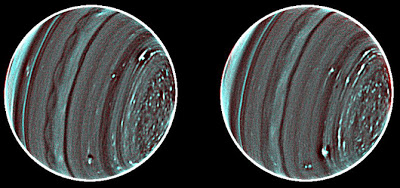

| Visitors Now: | |
| Total Visits: | |
| Total Stories: |

| Story Views | |
| Now: | |
| Last Hour: | |
| Last 24 Hours: | |
| Total: | |
Keck observations reveal Uranus in more detail than Voyager
From
The planet Uranus, known since Voyager’s 1986 flyby as a bland, featureless blue-green orb, is beginning to show its face. By using a new technique with the telescopes of the Keck Observatory, astronomers have created the most richly detailed, highest-resolution images ever taken of the giant ice planet in the near infrared, revealing an incredible array of atmospheric detail and more complex weather.
The planet, in fact, looks like many of the solar system’s other large planets — the gas giants Jupiter and Saturn, and the ice giant Neptune — said Imke de Pater, professor and chair of astronomy at the University of California, Berkeley, and one of the team members. The planet has bands of circulating clouds, massive swirling hurricanes and an unusual swarm of convective features at its north pole.
The two faces of Uranus as seen through the adaptive optics on the near-infrared camera of the Keck II telescope in Hawaii. The white features are high altitude clouds like Earth’s cumulous clouds, while the bright blue-green features are thinner high-altitude clouds akin to cirrus clouds. Reddish tints indicate deeper cloud layers. In each image, the north pole is at the right and is highlighted by small convective spots highly reminiscent of features seen on Saturn’s pole. Just south of the equator is a never-before-seen scalloped wave pattern similar to instabilities that develop in regions of horizontal wind shear. Click here for more detail on how image was created. Image courtesy of Lawrence Sromovsky, Pat Fry, Heidi Hammel, Imke de Pater.
Read more »
See more and subscribe to NextBigFuture at 2012-10-19 00:23:49 Source: http://nextbigfuture.com/2012/10/keck-observations-reveal-uranus-in-more.html
Source:



